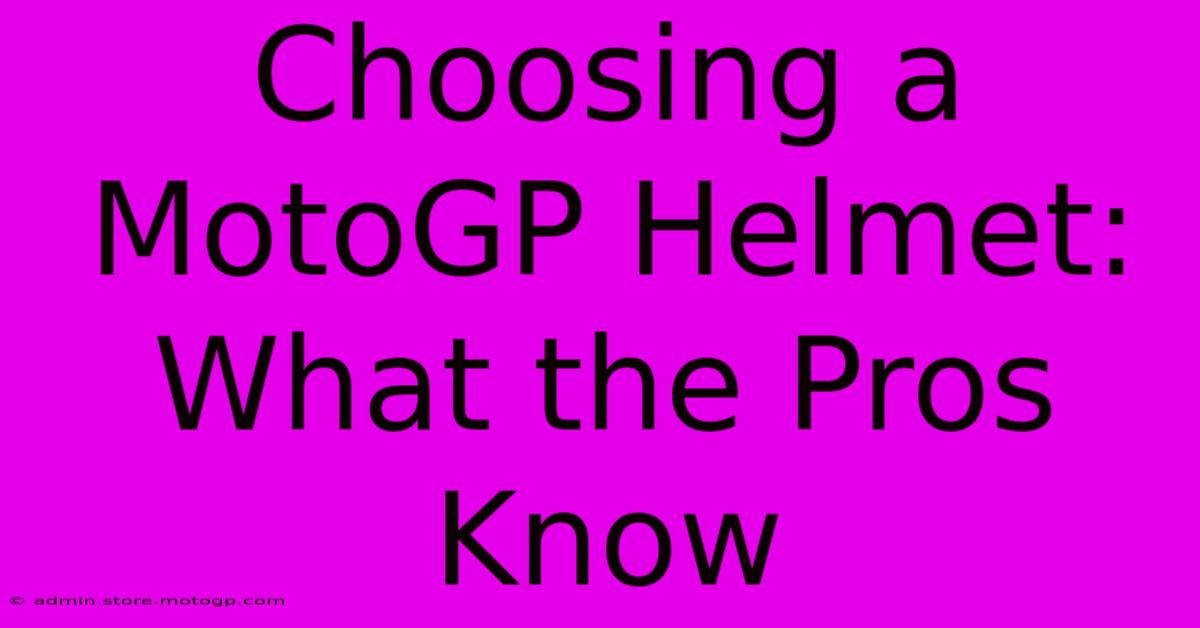Choosing A MotoGP Helmet: What The Pros Know

Table of Contents
Choosing a MotoGP Helmet: What the Pros Know
For aspiring racers and serious track day enthusiasts, choosing the right helmet isn't just about style; it's about safety, performance, and comfort—crucial factors that can significantly impact your riding experience. MotoGP riders, the elite of the motorcycle racing world, understand this better than anyone. Their helmet choices aren't arbitrary; they're the result of meticulous research, rigorous testing, and a deep understanding of what it takes to perform at the highest level. Let's delve into what separates a pro-level MotoGP helmet from the rest and how you can apply that knowledge to your own selection.
Safety First: Beyond the Shell
While the sleek aesthetics of a MotoGP helmet are undeniable, the core focus is always safety. Impact protection is paramount. Pros look for helmets exceeding the stringent safety standards set by organizations like Snell and FIM. These standards go beyond basic certifications, ensuring helmets can withstand extreme impacts and provide superior head protection in a crash.
Key Safety Features to Consider:
- Shell Material: Carbon fiber is the gold standard for its lightweight yet incredibly strong properties. Aramid fiber and other advanced composites are also frequently used. Look for helmets specifying the precise material used in their construction.
- Multi-Density EPS Liner: This is the crucial shock-absorbing layer within the shell. A multi-density liner provides varied levels of protection to different impact forces, offering better overall safety.
- Visor: The visor should meet or exceed the same safety standards as the helmet. Look for clear optical quality and potentially tear-off posts for racing conditions. Anti-fog and anti-scratch coatings are essential.
- Emergency Release System: A crucial safety feature allowing medical personnel to quickly remove the helmet in an emergency, minimizing the risk of further injury to the neck and spine.
Performance: Aerodynamics and Weight Matter
At MotoGP speeds, even minor aerodynamic inefficiencies can significantly impact performance and stability. Professional riders prioritize helmets with optimized aerodynamics to minimize drag and buffeting at high speeds. Weight is another key factor; a lighter helmet reduces neck strain, especially during long races or demanding track sessions.
Performance-Oriented Features:
- Aerodynamic Design: Look for helmets featuring wind tunnel testing and proven aerodynamic performance. Computational Fluid Dynamics (CFD) simulations are often used in design.
- Lightweight Construction: The lighter the helmet, the better. A helmet's weight can significantly impact neck fatigue, particularly during extended use.
- Ventilation: Effective ventilation is critical for maintaining rider comfort and preventing overheating, especially in hot conditions or during intense riding. Multiple intake and exhaust vents are desirable.
- Improved Communication System: This allows riders seamless integration with onboard electronics and their racing teams.
Comfort and Fit: A Personalized Approach
Comfort is not a luxury; it’s a necessity for optimal performance. A poorly fitting helmet can lead to discomfort, distraction, and even injury. MotoGP riders work closely with helmet manufacturers to ensure a perfect fit, often using custom-fitted liners and cheek pads.
Choosing the Right Fit:
- Proper Sizing: Get professionally fitted at a reputable motorcycle retailer. Do not rely solely on size charts.
- Interior Liner: The liner material should be comfortable against your skin and breathable. Removable and washable liners are a bonus for hygiene.
- Communication System Integration: If you plan on using a communication system, ensure the helmet is compatible and provides a comfortable fit with the unit installed.
Brands and Models: What the Pros Choose
While specific models vary depending on individual rider preferences and sponsorship deals, many top MotoGP riders utilize helmets from leading brands known for their safety, performance, and innovation. Researching the brands favoured by professional riders can give you a good starting point in your search.
Conclusion: Investing in Your Safety
Choosing a MotoGP-level helmet is an investment in your safety and performance. Don't compromise on safety or features; meticulously research different models, prioritize professional fittings, and understand the performance features that can significantly improve your riding experience. Remember, the right helmet can be the difference between a comfortable, enjoyable ride and a potentially catastrophic accident.

Thank you for visiting our website wich cover about Choosing A MotoGP Helmet: What The Pros Know. We hope the information provided has been useful to you. Feel free to contact us if you have any questions or need further assistance. See you next time and dont miss to bookmark.
Featured Posts
-
Austin F1 Qualifying Expect The Unexpected
Feb 19, 2025
-
Yamaha V4 Powering Your Adventures
Feb 19, 2025
-
F1 Austin Your Parking Questions Answered
Feb 19, 2025
-
Upgrade Your Gear Premium Replica Motorcycle Helmets
Feb 19, 2025
-
The Greatest Moto Gp Rider A Battle Of Wills
Feb 19, 2025
